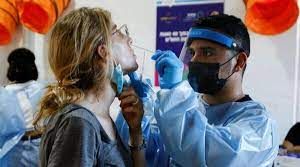UAE doctors have advised residents to ensure checks and proper care during quarantine if they test positive. A number of people are reporting mild symptoms after getting infected with COVID-19. Healthcare specialists recommend home isolation for mild symptoms, such as fever and cough. Furthermore, painkillers (such as paracetamol, ibuprofen, acetaminophen), cough suppressant syrups, zinc and vitamin C supplements can also help in curing the symptoms.
However, if symptoms worsen, patients are advised to hospitalise themselves from the emergency ward.
According to Dr Anum Iqbal Hafeez, general practitioner at Thumbay Clinic, Dubai, COVID-19 patients must contact their healthcare provider in case of symptoms like shortness of breath, pain or pressure in the chest or upper abdominal region, lose vision, sudden change in mental state, vomiting or diarrhoea, cough blood, or experiencing sleepy and lethargic physique.
Private hospital doctors are available to monitor the case and direct the patient to the nearest COVID-19 care facility. However, in case of mild symptoms, Dr Hafeez urged infected patients to inform the people they interacted and places they visited before testing positive.
"One should avoid visiting public places and leave their home only to get medical care," she added.
Dr Ahmed Al Mansoury, pulmonology consultant, NMC Royal Hospital, Sharjah, also called on patients to keep an oximeter handy to check saturation levels and monitor the intensity of the infection. Patients with saturation levels below 94 percent must contact their healthcare provider.
Furthermore, fully vaccinated people under the age of 65 and with no severe health conditions can monitor their health condition at home.
Dr Anum has provided necessary guidelines that must be followed by COVID-infected patients:
· Stay away from friends, family members and others as much as possible
· Isolate yourself in a separate room with a separate bathroom, if available
· Regularly monitor symptoms and measure temperature
· Maintain high levels of hygiene. Frequently wash hands with soap and water for at least 20 seconds
· Use an alcohol-based hand sanitiser that contains 60 to 95 percent alcohol
· Avoid touching eyes, nose, and mouth with unwashed hands
· Maintain a daily routine, including showering and getting dressed
· Eat healthy meals and stay hydrated
· Have plenty of rest and sleep
· Keep up your fluids
· Treat pain and fever symptoms with over-the-counter medications if needed
· Avoid excessive use of alcohol and tobacco
· If you have access to an oxygen monitor, use it three times a day or more if facing trouble in breathing. Do not rely on a smart watch or phones for monitoring oxygen levels.
For families:
· Ensure shared spaces in the home have good airflow
· Avoid sharing household items with the patient
· Wash those items properly after every use by the patient
· Disposable plates and utensils can be used for maximum protection
· Thoroughly clean all “high-touch” surfaces, such as counters, tabletops, doorknobs, bathroom fixtures, toilets, phones, keyboards, tablets, and bedside tables on a daily basis
· Patient should wear a face mask when around other people
· Caregivers must be limited in number for patients to avoid contact
· All household members should stay home and visitors should not be permitted
 AR
AR UR
UR
